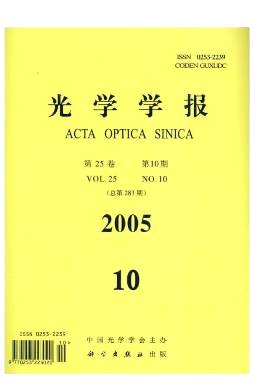光学学报, 2005, 25 (10): 1339, 网络出版: 2006-05-23
光纤马赫曾德尔干涉法测量极化聚合物的电光系数
Testing Electro-Optic Coefficients of Poled Polymers by Fiber-Optic Mach-Zehnder Interferometer
光纤通信 光电子器件 极化聚合物 电光系数 马赫曾德尔干涉仪 optical communication poled polymer electro-optic coefficient fiber-optic Mach-Zehnder interferometer
摘要
报道了用光纤马赫曾德尔干涉法测量极化聚合物电光系数的方法和原理。该方法不仅可以测量聚合物薄膜的电光系数而且可以测量聚合物波导的电光系数,并且该方法可以同时测量聚合物的电光系数张量元r13和r33。该方法最突出的优点是不必在聚合物薄膜的表面制备第二个电极,因此尤其适合于在电光聚合物试制阶段测试聚合物的电光系数。干涉仪的输出被反馈到参考臂中控制相位偏置点的压电陶瓷,从而实现对干涉仪相位偏置点的闭环控制,因此降低了对环境稳定性的要求并且提高了测量精度。实际测试了极化聚合物薄膜PMMA-DR1的电光系数张量,其测量值r13=8.3 pm/V,r33=257 pm/V。
Abstract
It is proposed and demonstrated that the fiber-optic Mach-Zehnder (M-Z) interferometer measures accurately the electro-optic (EO) coefficients of, not only the polymer thin film, but also the polymer waveguide. Furthermore, the tensor components, r13 and r33, of EO coefficient can be measured simultaneously. In contrast with the free space M-Z interferometer, the fiber-optic M-Z interferometer has some advantages, such as compact devices, simple experimental configuration, easy operation, and good stability. The outstanding advantage is that the second electrode need not be fabricated on the top of the polymer thin film. So, the measurement system is especially suitable to measure EO coefficients of the polymer samples on trial. In the measurement system, the interference output is fed back and controls the phase bias of the interferometer to decrease the requirement of the environmental stability and increase the measurement precision. The EO coefficient measurements of the PMMA-DR1 sample are r13=8.3 pm/V and r33=25.7 pm/V.
王义平, 陈建平, 李新碗, 洪建勋, 张晓红, 周俊鹤, 叶爱伦. 光纤马赫曾德尔干涉法测量极化聚合物的电光系数[J]. 光学学报, 2005, 25(10): 1339. 王义平, 陈建平, 李新碗, 洪建勋, 张晓红, 周俊鹤, 叶爱伦. Testing Electro-Optic Coefficients of Poled Polymers by Fiber-Optic Mach-Zehnder Interferometer[J]. Acta Optica Sinica, 2005, 25(10): 1339.





